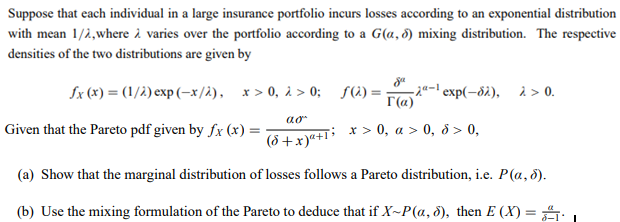Suppose that each individual in a large insurance portfolio incurs losses according to an exponential distribution with mean 1/2,where à varies over the portfolio according to a G(a,5) mixing distribution. The respective densities of the two distributions are given by fx (x) = (1/2) exp (-x/¿), x>0, 2 > 0; S(1) = -2ª-' exp(-di), i > 0. Га) ao Given that the Pareto pdf given by fx (x) = (5+x)e+1 * > 0, a > 0, 8> 0, (a) Show that the marginal distribution of losses follows a Pareto distribution, i.e. P(a,3). (b) Use the mixing formulation of the Pareto to deduce that if X~P(a, d), then E (X) =-,
Suppose that each individual in a large insurance portfolio incurs losses according to an exponential distribution with mean 1/2,where à varies over the portfolio according to a G(a,5) mixing distribution. The respective densities of the two distributions are given by fx (x) = (1/2) exp (-x/¿), x>0, 2 > 0; S(1) = -2ª-' exp(-di), i > 0. Га) ao Given that the Pareto pdf given by fx (x) = (5+x)e+1 * > 0, a > 0, 8> 0, (a) Show that the marginal distribution of losses follows a Pareto distribution, i.e. P(a,3). (b) Use the mixing formulation of the Pareto to deduce that if X~P(a, d), then E (X) =-,
Chapter6: Exponential And Logarithmic Functions
Section6.8: Fitting Exponential Models To Data
Problem 3TI: Table 6 shows the population, in thousands, of harbor seals in the Wadden Sea over the years 1997 to...
Related questions
Question

Transcribed Image Text:Suppose that each individual in a large insurance portfolio incurs losses according to an exponential distribution
with mean 1/2,where i varies over the portfolio according to a G(a, 3) mixing distribution. The respective
densities of the two distributions are given by
Sx (x) = (1/2) exp (-x/à), x > 0, 2 > 0; S(2) =-
T(a)
2-l exp(-8i), 2 > 0.
Given that the Pareto pdf given by fx (x) =
(5 +x)ª+1 * > 0, a > 0, 8> 0.
(a) Show that the marginal distribution of losses follows a Pareto distribution, i.e. P(a, 5).
(b) Use the mixing formulation of the Pareto to deduce that if X~P(a, 5), then E (X) = .
Expert Solution
This question has been solved!
Explore an expertly crafted, step-by-step solution for a thorough understanding of key concepts.
Step by step
Solved in 3 steps

Recommended textbooks for you


Algebra & Trigonometry with Analytic Geometry
Algebra
ISBN:
9781133382119
Author:
Swokowski
Publisher:
Cengage

Trigonometry (MindTap Course List)
Trigonometry
ISBN:
9781337278461
Author:
Ron Larson
Publisher:
Cengage Learning


Algebra & Trigonometry with Analytic Geometry
Algebra
ISBN:
9781133382119
Author:
Swokowski
Publisher:
Cengage

Trigonometry (MindTap Course List)
Trigonometry
ISBN:
9781337278461
Author:
Ron Larson
Publisher:
Cengage Learning